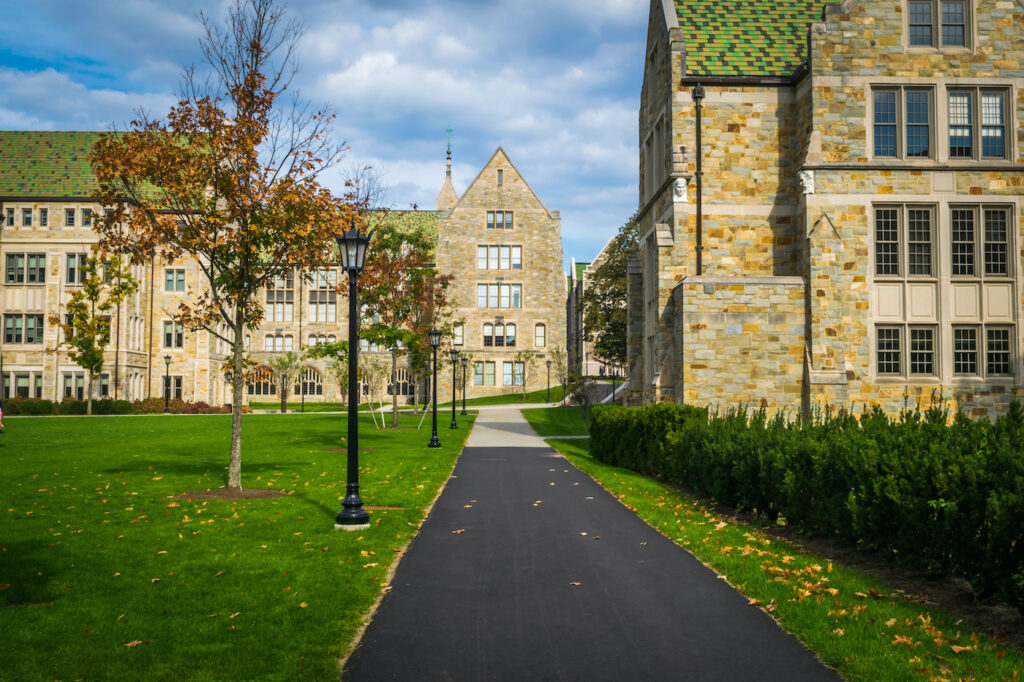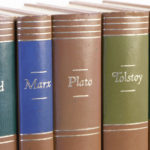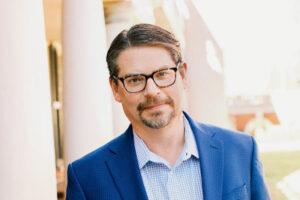The dust jacket of John Agresto’s new book, The Death of Learning: How American Education Has Failed Our Students and What to Do about It, depicts Gore Hall at Harvard in the 1870s. Perhaps this is a subtle indication of what lies within: Gore Hall, Harvard’s first proper library, was demolished in 1913. To be sure, it was replaced by the grand Widener Library, which is a treasure. But will it remain a treasure? In September 2020, the university announced in a press release that “Harvard Library has begun building an Anti-Racism team,” appointing its “first Anti-Black Racism Librarian/Archivist,” who “will work with colleagues across Harvard Library on objectives relating to centering anti-racism and diversity in our collections lifecycle.” Imagine being paid to string words together like this about a “collections lifecycle”—at Harvard.
But you don’t have to imagine: this is what has become of education in this country, not only at Harvard but pretty much everywhere. The situation, summed up in a sentence by Agresto: “There’s no way to view this as other than a tragedy.” Particularly insidious is that, unlike most examples of political attacks on education in the past, the recent “dismantling of the liberal arts comes from . . . within”:
It comes from radicalized departments of history, literature, classics, American studies, and all the myriad of other studies connected to ethnopolitical interest groups. It comes from virtually every school and college of education. This is why I have no hesitation in saying that liberal education in America is dying not by murder but by suicide.
Describing the self-destruction with grace, care, and regular doses of humor, Agresto does his best to imagine a better future. A superb writer who largely avoids inflammatory rhetoric, he is the rare gifted administrator who appears to have lost none of his humanity or sense of wonder when he entered the upper echelons of academic bureaucracy: as acting chair of the National Endowment for the Humanities in the mid-1980s, then as president of St. John’s College in Santa Fe from 1989 to 2000, and more recently as a founding trustee of the American University of Iraq, Sulaimani.
Start your day with Public Discourse
Sign up and get our daily essays sent straight to your inbox.What are the liberal arts? This is Agresto’s pithy explanation, which he provides in highlighting italics: “a way of understanding the most important questions of human concern through reason and reflection.” He writes that “the liberal arts hold out the promise of freeing each of us from the captivity of prejudice, of platitudes and superstition, or of whatever it is that ‘everyone’ believes” and “aim at once to be truly radical and truly conservative,” demanding that individuals acquire a foundation in the wisdom of the past so that they can truly think for themselves.
Endangered Education
Unfortunately, he laments, “a rich and thoroughgoing liberal arts education [now] seems to me as endangered as the Sumatran orangutan.” As he goes on to note, when he first began to think about the book, nearly three decades ago, he drafted such sentences as “It’s clear that in the realm of education the words ‘liberal arts’ have always been words of high praise” and commented on how very rare it was to find a “faculty of liberal arts that does not think of itself as the crown jewel of the whole educational enterprise.” How things change.
Yet even in the 1980s, the bonfire of the humanities was well underway. Agresto knows this, of course. Indeed, he spends a good number of pages on the dismantling of Stanford’s Western Culture curriculum, which was last taught in 1987–88. Some five hundred protesters, including Jesse Jackson, initiated this fight by marching on campus chanting, “Hey ho, ho ho, Western Civ has got to go!” The march took place in January 1987; in February, Agresto’s teacher Allan Bloom published The Closing of the American Mind; and at the end of March 1988, the game was finally up when the Faculty Senate voted 39 to 4 to revamp the course to make it more global and, supposedly, less racist and sexist.
The fact is that the humanities—historically a subsection of the liberal arts: literature, music, history, etc.—have been in deep trouble for a long time. It is difficult to find a basic course on Shakespeare at most of the better-known colleges and universities; the rise of STEM, for all its wonders, has led in recent months to the Pandora’s box known as ChatGPT; and, worst of all, today’s would-be defenders of the humanities often don’t seem to have any idea what they’re defending or how to do it.
Part of the challenge is that defending the liberal arts involves clusters of questions and debates rather than a clearly articulated set of principles. Life’s biggest questions are almost never resolved to everyone’s satisfaction, and if we don’t study the differences between the Epicureans and the Stoics, between Locke and Rousseau, and between legal originalists and non-originalists, we are missing out on our own music: sometimes a battle of the bands, sometimes cacophony, always fascinating.
The diverse nature of the liberal arts means that to be educated means knowing not only the proverbial “best that has been thought and said in the world” but also the also-rans. “[W]e understand better the Founders’ Constitution,” Agresto writes, “by reading the writings of various Anti-Federalists alongside The Federalist Papers.” And beyond this: a liberal education should also “com[e] to grips with the very worst that has been said and done and understanding why.”
If we don’t study the differences between the Epicureans and the Stoics, between Locke and Rousseau, and between legal originalists and non-originalists, we are missing out on our own music: sometimes a battle of the bands, sometimes cacophony, always fascinating.
Agresto firmly rejects the idea that people who study the humanities are more humane, perhaps even more human, than those who do not. Obviously he is correct about this. “Are we humanists and liberal artists actually more moral than . . . owners of delicatessens?” Agresto asks. I am the grandson of owners of a delicatessen who did not attend college, and I have no hesitation in saying that they were more moral than both I and most people I have known in decades in academia.
It is one thing to extol the extraordinary, as we should all do. But it is deeply wrong to disdain or condemn the ordinary. Yet this is how the American elite is now acting. “[O]rdinary family life, heterosexuality, simple love of country, traditional virtues, traditional religious habits and outlooks”—all are under regular attack at institutions of higher learning, which at the same time present students with such gotcha questions as “Have you ever been to a gay or lesbian bar, social club, or march? If not, why not?” (courtesy of North Dakota State). It is good to remember Cardinal Newman, as Agresto of course does: “a University training is the great ordinary means to a great but ordinary end.”
For Social Justice Warriors, however, there is a horrifying new “ordinary.” Here’s how Agresto puts it, after reminding us that Social Justice was the name of Father Coughlin’s virulently anti-Semitic journal:
The last thirty years have seen the vandalizing of ever so much of higher education. The supposed reformers have entered the storehouse of centuries of accumulated knowledge, torn down its walls, thrown out its books, and toppled its monuments. For all their brave talk of justice, they have carried out what has to be seen as one of the most intellectually criminal acts of the ages, the modern equivalent of burning the libraries of antiquity. Today, acts that were unthinkable, unimaginable, just years ago now seem so very ordinary.
Agresto’s book is liberal, largely moderate, and explicitly American: liberal not as opposed to “conservative,” but in the sense of being about freedom (Latin libertas, the source of our “liberty”); moderate because moderation is “the virtue a liberal education cultivates best, as well as the virtue for which it is often criticized most”; and American for the reason that “[b]ecause we are diverse, for each of us ‘our own’ means not only what we hold in common but also what we hold separately.” This defense of liberal education will especially resonate with readers like me who at least used to consider themselves liberal, who try when possible to occupy the middle ground, and who find themselves increasingly aggressive about promoting American ideals and institutions.
It is one thing to extol the extraordinary, as we should all do. But it is deeply wrong to disdain or condemn the ordinary. Yet this is how the American elite is now acting.
Underestimating Outrage
Though it is at times repetitive, you can pick up The Death of Learning and read almost any chapter on its own and be edified. But the greatest flaw, in my view, is that Agresto does a better job of explaining “how American education has failed our students” than “what to do about it.” Not that he doesn’t say the right things: about the desirability of investing large sums in small liberal arts colleges; the importance of winning over the young and those who teach them (for which reason he ends the book with two heartfelt exhortations: “A Message to High School Teachers and Principals” and “A Message to High School Seniors”); and the possibilities that new universities offer—from Austin, Texas (disclosure: I am on the advisory board of the University of Austin) to the Kurdistan Region of Iraq. But, as I have already hinted, I found in the second half of the book more wishful thinking than original policy suggestions.
There are also a few spots where Agresto gets things wrong. Sometimes he should know better. Most egregious is his valorization of Anthony Fauci, who majored in classics at Holy Cross. Agresto links him with Martin Luther King Jr. as “discerning men of public presence, insight, persuasiveness, and judgment—and thus capable of doing great things,” but I for one would not use him as an exemplar of why a “liberal arts education [is] something peculiarly important and estimable” (italics in original).
On other occasions, however, Agresto overestimates goodwill and overlooks the extent of academic outrage about certain topics. He may be at his strongest when he explains how a liberal education can be not merely of value to us as individuals but of genuine use—Agresto does not shy away from this word—to our collective well-being as a country. He highlights the education and sense of civic responsibility of three of America’s Founding Fathers and its nineteenth-century “refounder,” but fails to note that in the past three years, prominent statues of Thomas Jefferson and Abraham Lincoln have been taken down or that James Madison’s estate, Montpelier, has become aggressively woke.
Fair enough, perhaps. But would he have predicted that a statue of John Witherspoon that an elite university erected as recently as 2001 would now be under serious threat? As I write, the Princeton administration is debating what to do about a prominently placed representation of the only clergyman and only college president to sign the Declaration of Independence: a citizen of the world after whom the organization that publishes Public Discourse is named. (Disclosure: Princeton fired me last year, but I remain a Senior Fellow at the Witherspoon Institute.) The controversy has made national news, including in these pages. To those who would take down the statue, I offer Witherspoon’s admonition to Princetonians of long ago: “Do not live useless and die contemptible.”
Let me end on a positive note. In his salutary reflections on an “alliance” between the liberal arts and vocational education, Agresto quotes Booker T. Washington, who was assuredly neither useless nor contemptible. Of a student who made use of grammar, chemistry, and other bookish subjects in the raising of an acre of splendid cabbages, Washington wrote, “[T]here is just as much that is interesting, strange, mysterious, and wonderful; just as much to be learned that is edifying, broadening, and refining in a cabbage as there is in a page of Latin.” He was right, and I’ll add to the discussion Pliny the Elder’s statement in the first century A.D., Brassicae laudes longum est exsequi (“it would be a lengthy business to enumerate the glories of the cabbage”).
Learning in all its forms can and must be saved. We do not live in the best of all possible worlds, and it is time for everyone to stop the destructive nonsense and return to cultivating our precious gardens, both agricultural and academic.














